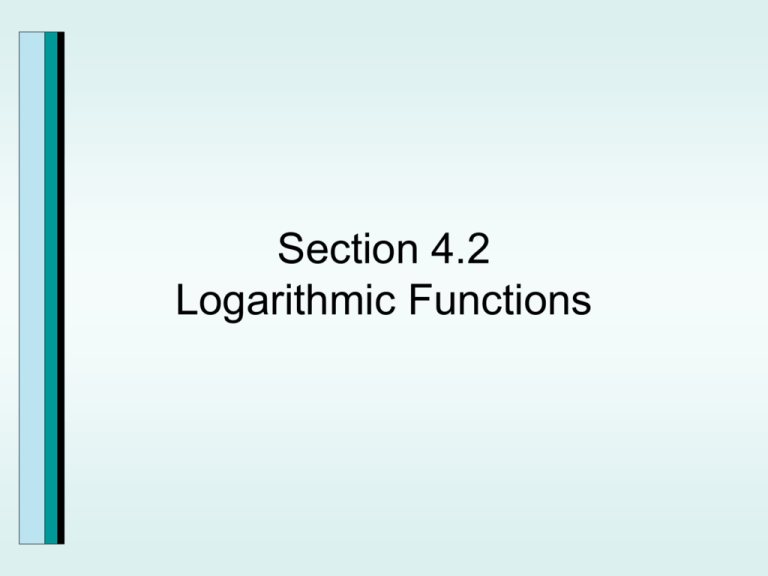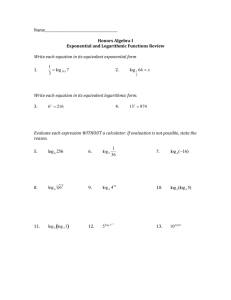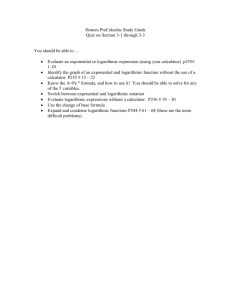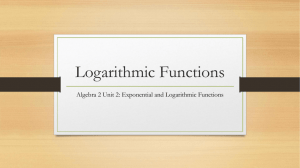4.2_Logarithmic Functions
advertisement

Section 4.2 Logarithmic Functions The Definition of Logarithmic Functions To change from logarithmic form to the more familiar exponential form, use the pattern; y=log b x means b y x Example Write each equation in the equivalent exponential form. a. 4=log 2 x b. x=log3 9 Example Write each equation in its equivalent logarithmic form. a. b 4 16 b. 52 x Example Evaluate. a. log 3 81 b. log 36 6 c. log 51 y log a x = x a y • Evaluate the following… f ( x) log2 32 f ( x) log4 2 1 f ( x) log10 100 f ( x) log3 1 TI Cares! • Calculator Applications: the common log (log button on the calculator) uses the common base, 10. f ( x) log10 10 f ( x) log f ( x) log10 2.5 f ( x) log10 2 1 10 3 Basic Logarithmic Properties Examples: log8 8 1 log6 1 0 Examples: log 7 7 2 2 5log5 8 8 The voice balloons should help you see the "undoing" that takes place between the exponential and logarithmic functions in the inverse properties. Example Use the properties of logarithms to find the answers. a. 3log3 15 b. log 2 23 c. log 9 9 d. log 1 3 3 Find… ln e 3 log a a log 7 1 2 log2 16 Entrance Slip 1) Write the exponent in log form 4 64 3 3 2 25 125 2) Evaluate the following log 9 3 1 log 4 4 log 2 16 Graphs of logarithmic Functions Example Use transformations to graph g(x)=2+log 3 ( x 3). Start with log 3 x. y x Example Use transformations to graph g(x)=-log3 x y x Example Use transformations to graph g(x)=log3 ( x) y x The Domain of a Logarithmic Function We learned that the domain of an exponential function of the form f(x)=b x includes all real numbers and its range is the set of positive real numbers. Because the logarithmic function reverses the domain and the range of the exponential function, the domain of a logarithmic function of the form f(x)=log b x is the set of all positive real numbers. In general, the domain of f(x)=log b g ( x) consists of all x for which g(x)>0. Example Find the domain of f(x) = log 4 ( x 5) Common Logarithms Example I Use the formula R=log to solve the problem. If an I0 earthquake is 100 times as intense as a zero-level quake (I=100 I 0 ), what is its magnitude on the Richter Scale? Natural Logarithms The logarithmic function with base e is called the natural logarithmic function. The function f(x)=log e x is usually expressed as f(x)=ln x. Like the domain of all logarithmic functions, the domain of the natural logarthmic function f(x)=ln x is the set of all positive real numbers. Thus the domain of f(x)= ln g(x) consists of all x for which g(x)>0. Example Evaluate. a. ln e 2 b. e ln 5 Example y log 3 x 2 4 2 -5 5 -2 -4 -6 y log 6 x 2 Example 4 2 -5 5 -2 -4 -6 y log 5 x 2 3 Example 4 2 -5 5 -2 -4 -6 1) y log 4 x 2) y ln( x 4) 3) y ln x 3 4) y 2 ln x 5) y log( x 5) 6) y 3 log( x 2) 7) y 3 log x 8) y 2 log( x 1) 9) y 2 log 2 x 10) y 1 log 5 ( x 6) Graph the following… 1) 2) 3) 4) 5) 6) 7) 8) Exit Slip Graph the following logarithmic equations. 1) log 5 x 2) 6 log 4 x 3) 4 log 6 x 5 4) log x 3 1





